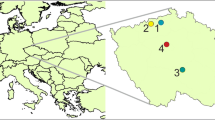Abstract.
Aerosols play an important role in radiative transfer processes involved in different fields of study. In particular, their influence is crucial in the attenuation of light at astronomical and astrophysical observatories, and has to be taken into account in light transfer models employed to reconstruct the signals. The Andean Argentinean region is increasingly being considered as a good candidate to host such facilities, as well as the ones for solar-energy resources, and an adequate knowledge of aerosols characteristics there is needed, but it is not always possible due to the vast area involved and the scarce atmospheric data at ground. The aim of this work is to find correlations between aerosol data and particle trajectories that can give an insight into the origin and behaviour of aerosols in this zone and can be employed in situations in which one does not have local aerosol measurements. For this purpose, an aerosol spectrometer and dust monitor (Grimm 1.109) was installed at the Pierre Auger Observatory of ultra-high-energy cosmic rays, to record aerosol concentrations in different size intervals, at surface level. These measurements are analysed and correlated with air mass trajectories obtained from HYSPLIT (NOAA) model calculations. High aerosol concentrations are registered predominantly when air masses have travelled mostly over continental areas, mainly from the NE direction, while low aerosol concentrations are found in correspondence with air masses coming from the Pacific Ocean, from the NW direction. Different size distribution patterns were found for the aerosols depending on their origin: marine or continental. This work shows for the first time the size distribution of aerosols registered at the Pierre Auger Observatory. The correlations found between mass and particle concentrations (total and for different size ranges) and HYSPLIT air mass trajectories, confirm that the latter can be employed as a useful tool to infer the sources, evolution and characteristics of the aerosols.
Similar content being viewed by others
References
A. Aab et al., Nucl. Instrum. Methods Phys. Res. A 798, 172 (2015)
J. Abraham et al., Astropart. Phys. 33, 108 (2010)
M.I. Micheletti, L.G. Murruni, M.E. Debray, M. Rosenbusch, M. Graf, G. Ávila Cadena, P. Vitale, J. Davidson, H. Somacal, Nucl. Instrum. Methods Phys. Res. B 288, 10 (2012)
R.R. Draxler, G.D. Rolph, HYSPLIT (HYbrid Single-Particle Lagrangian Integrated Trajectory), Model access via NOAA ARL READY website, http://www.arl.noaa.gov/HYSPLIT.php, NOAA Air Resources Laboratory, College Park, MD (2013)
G.D. Rolph, Real-time Environmental Applications and Display sYstem (READY), http://www.ready.arl.noaa.gov, NOAA Air Resources Laboratory, College Park, MD (2013)
K. Louedec, Pierre Auger Collaboration, R. Losno, Eur. Phys. J. Plus 127, 97 (2012)
K. Louedec, Pierre Auger Collaboration, J. Phys.: Conf. Ser. 409, 012236 (2013)
A. Aab et al., Atmos. Res. 149, 120 (2014)
NOAA Air Resources Laboratory (ARL), Global Data Assimilation System (GDAS1) archive information, tech. report, http://ready.arl.noaa.gov/gdas1.php (2004)
P. Abreu et al., Astropart. Phys. 35, 591 (2012)
V. Rizi, A. Tonachini, Pierre Auger Collaboration, M. Iarlori, G. Visconti, Eur. Phys. J. Plus 127, 92 (2012)
J.N. Porter, A.D. Clarke, J. Geophys. Res. 102, 6035 (1997)
D. Morata, M. Polvé, A. Valdés, M. Belmar, M.I. Dinator, M. Silva, M.A. Leiva, T. Aigouy, J.R. Morales, Environ. Geol. 56, 81 (2008)
R.D. Piacentini, B. García, M.I. Micheletti, G. Salum, M. Freire, J. Maya, A. Mancilla, E. Crinó, D. Mandat, M. Pech, T. Bulik, Adv. Space Res. 57, 2559 (2016)
Martin Will, private communication
Author information
Authors and Affiliations
Corresponding author
Rights and permissions
About this article
Cite this article
Micheletti, M.I., Louedec, K., Freire, M. et al. Aerosol concentration measurements and correlations with air mass trajectories at the Pierre Auger Observatory. Eur. Phys. J. Plus 132, 245 (2017). https://doi.org/10.1140/epjp/i2017-11503-0
Received:
Accepted:
Published:
DOI: https://doi.org/10.1140/epjp/i2017-11503-0




